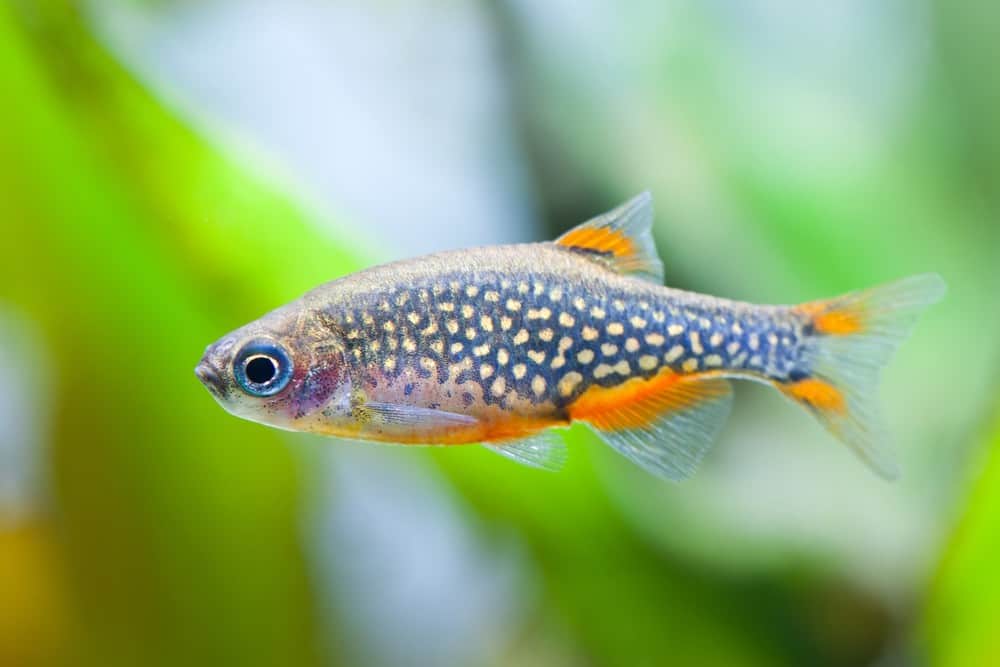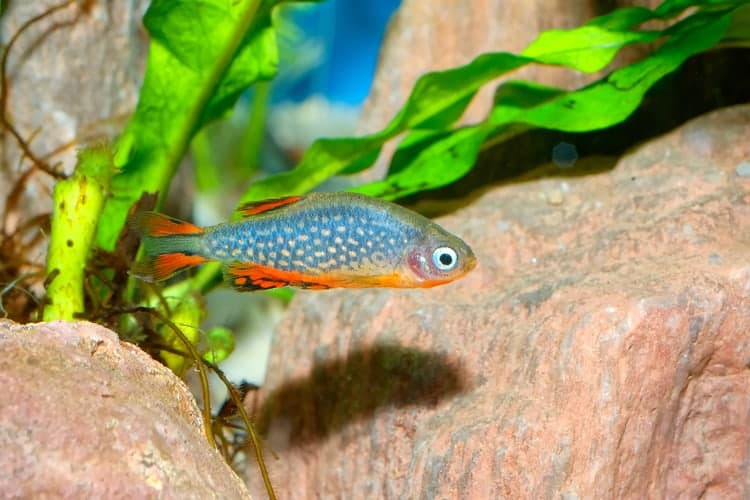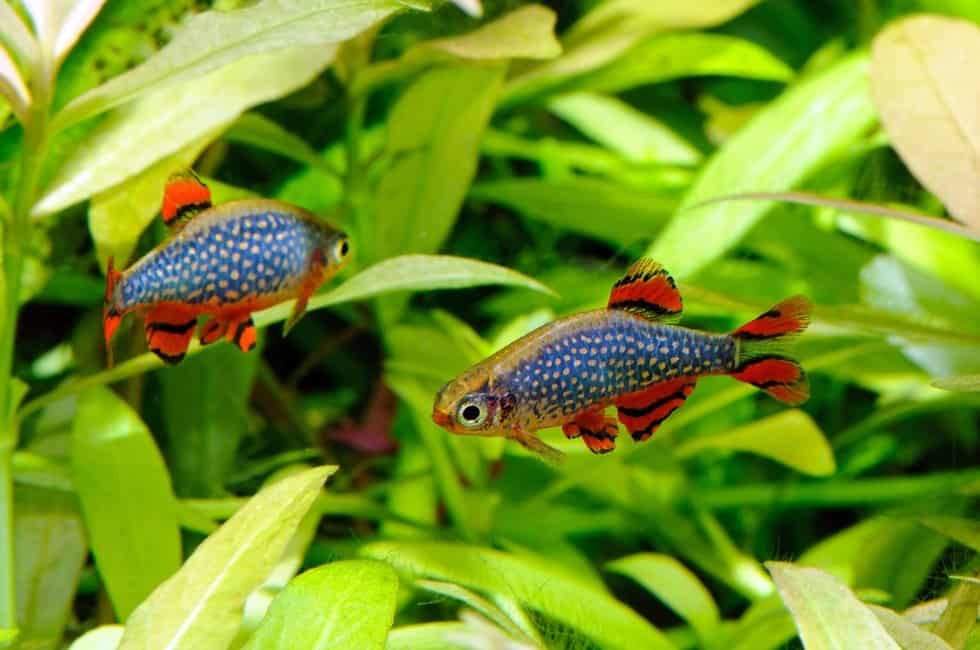Celestial Pearl Danio (Galaxy Rasbora), is an exotic freshwater fish extremely popular among aquarists, especially beginners. With a beautiful appearance and exuberant energy, this little fish takes its name from its most remarkable feature: its coloring.
If you do not have much experience with exotic fish, and want your fish to reproduce, then Celestial Pearl Danio is definitely the best choice.
Origin and Habitat
In the past, Celestial Pearl Danio fish have populated the quieter waters of Southeast Asia, from Pakistan to Myanmar. But nowadays, because of habitat alteration and even fishing for the exotic fish trade, this little Danio is found only in eastern India (in the great Ganges), Bangladesh and possibly Bhutan.
Overall the Celestial Pearl Danio prefers calm waters in rivers, canals, ponds, flooded land, etc. You may even find it in rice fields, which are well-irrigated. There are populations of Celestial Pearl Danio in some rivers in the US and Colombia. These have probably come from exotic fish breeding.
Description
The Celestial Pearl Danio is part of the family Cyprinidae, genus Danio. It is a small fish that measures only 4-5 cm. The body is elongated, silver, and horizontally furrowed with 5 dark blue stripes, which start from the head and end up on the caudal fin.
Some sources state that the space between blue bands is colored differently in males and females. The male will have open lines of golden color, whereas they are more gray-yellow in females.
There are also albino or leopard specimens. Although these are often considered to be a separate species, genetic tests have proved to the contrary. The mouth is oriented upwards, as the fish is predominantly found at the surface of the water.
Both sexes have 2 pairs of mustaches around their lips. The female is bigger than the male, having denser, lighter coloring. In some specimens, swimmers can be better developed, giving a veiled appearance that damages speed, making these fish slower.
Celestial Pearl Danio, as found in nature, has an aerodynamic body that is slim, slightly flattened on the side and with a length:width ratio of about 5:1. They have relatively short swimmers, an upward facing mouth (allowing them to feed from the surface of the water) with short (barely visible) mustaches.
It has no median line. In the aquarium, there are several different varieties of this species. Selective reproduction has created a veiled variety. Unfortunately, the veils, as with the veiled varieties of other species, prevent movement and mean that the fish get tired much more quickly. As a consequence, often veiled specimens are less active, and more sensitive to the aggressive fish in the aquarium.
It seems that the frankei or leopard variety, which has small blue spots instead of the longitudinal stripes was created through spontaneous mutations.
Originally thought to be a new species, it was even given its own name (Danio Frankei). However it was then discovered to be capable of cross breeding with Celestial Pearl Danio (resulting in non-sterile progeny), meaning that it is not actually very different from Celestial Pearl Danio. Certainly it is not different enough to be called a different species, so it has now been decided that it is a variety of the Celestial Pearl Danio species.
By crossing the basic variety, a hybrid variety can be created, with both stripes and dots. Albinism, the result of a genetic defect, is more rarely encountered.
Genetic engineering by the National University of Singapore in the last 20 years has resulted in new colors, including red, yellow, green, etc.
The Celestial Pearl Danio is a real star in the field of genetic research – as it is easy to look after, easy to breed and quick growing.
The Celestial Pearl Danio is a peaceful and very sociable fish. They are very sociable fish that like to live in groups, so it’s recommended that hobbyists keep a minimum of eight fish. They are energetic fish and, although they prefer to swim near the surface, they will elegantly swim through the entire aquarium.
Behavior
The Celestial Pearl Danio is a lively fish, always darting from side to side in the aquarium, always playing and chasing other fish. It is a peaceful fish, but it won’t hesitate to eat fry from their own species, or from other fish in the tank.
However, the fact that it is so lively makes it an unsuitable tank mate for quieter species, which would become stressed by the constant activity.
Being a quick fish, it is sometimes used as an aquarium partner for generally aggressive fish; This only applies to the native variety, as the veiled fish are too slow and will be easily caught.
The fact that this fish is very lively, combined with the fact that you need a group of at least 8 means that you need a decent sized aquarium that is at least 60cm long, and preferably 1m long. At the same time, these fish need a well-planted aquarium. They especially like fine-leafed plants that they can dart in and out of and that will give them a hiding place for a brief rest.
Although predominantly surface feeders, the Celestial Pearl Danio won’t hesitate to compete for food with other species that feed at the bottom of the water. It doesn’t leave any safe areas in the tank for other species of fish as it is often found in all three areas of the aquarium (surface, mid-water and bottom).
You can put it in a tank with other species of fish, but just make sure that their tank mates are not too temperamental or aggressive. The Celestial Pearl Danio is a generally peaceful fish and will not feel threatened by other fish of the same size or smaller.
The fish will easily adjust to a variety of water conditions and therefore are easy to keep, even for novice aquarists. However, remember to follow the basic rules of aquarium fish care.
Compatibility
Being a docile fish, the Celestial Pearl Danio can mix with many other fish.
Males may be rather quarrelsome and often flare, spar, and fight, resulting in minor splits to the fins. Many fish owners with six or more Celestial Pearl Danios have observed shoaling in their fish, and in males, several have reported minor territoriality.
In the aquarium
Even though they are a relatively small fish, Danio needs a lot of space to swim vigorously. For a group of 8-10 members, an aquarium of at least 60 liters is required.
The aquarium needs a lid (with ventilation holes of course!) as, being surface swimmers, these fish can jump out.
In terms of temperature, the Celestial Pearl Danio prefers the temperature to be between 18°C and 24°C.
However, it can withstand temperatures lower, and even higher, up to 30°C.
Water hardness should be between 5 and 12, and the pH needs to be between 6 and 7. The aquarium water also needs to be well oxygenated and filtered.
The aquarium can be decorated with natural plants. These should preferably be placed at the back of the tank, leaving the front and the sides clear to allow the fish to swim freely. When they get tired or feel threatened, the fish will retreat to the shelter provided by the plants.
Choose a substrate and darker décor to better highlight the Celestial Pearl Danios’ appealing coloring. Do not forget the lighting, which will complete the beautiful underwater painting.
Because of its small size, this beautiful little cyprinid would be best in a small aquarium, away from bigger fish that might think they would be good to eat!
There are many small aquariums that you can use to house Danios, one example being an AquaCube.
Diet
Celestial Pearl Danio is an omnivorous fish. They are happy with dry food, but from time to time can be spoiled with some live food. Artemia, daphnia or bloodworm are a real culinary delight. You can also feed them with spirulina pills.
Being natural omnivores, they need a variety of food (plant and animal origin) in order to receive all the necessary nutrients.
Trade food (flakes, granules, chips) has all the necessary components (fish flour, zooplankton and phytoplankton, vitamins, minerals etc.).
Celestial Pearl Danios also like other types of dry food such as lyophilized tubers, chironomid larvae, spirulina pills, etc. which can be given periodically for variation.
Although they will eat (and enjoy!) frozen artemia, live food is preferable (artemia, mosquito larvae etc.). However, I would avoid feeding them with tubifex as the risk of disease is just too high.
There is practically no food that they won’t eat! And in fact this sometimes makes them hard to keep in a tank with slower fish that might not get to the food in time!
Reproduction
During reproduction, the male must be present for ovulation. The female will deposit a few hundred eggs in several different places in the aquarium (or on the shore if it is in the wild).
Fertilized eggs become transparent, which is why this species was chosen for research. Development takes place quickly, with most organs appearing within the next 36 hours.
Incubation takes place in the next 12 to 36 hours, depending on external conditions and temperature.
The little ones quickly begin to swim and feed. At this point, their sex can only be determined by dissection.
In large groups, males will mate with any available female. Although we do not yet know whether there are elements of attraction between a male and a female, we do know that the presence of plants, even plastic ones, encourages spawning.
It is very easy to breed these fish in captivity. You only need a 20 liter aquarium filled with water from the community aquarium (using the same water means that the fish won’t be shocked by differing water conditions). Place a large net (3mm-4mm mesh) on the bottom of the aquarium to prevent egg attack by the parents. A substrate is not necessary, but you could put in some plants to encourage spawning (for example, I’d recommend Ceratophillum Demersum).
Female Celestial Pearl Danios lay eggs in groups, so each female needs 2-3 males to fertilize the eggs. Therefore you need to make sure that the breeding group contains more males than females.
Bridal dancing and spawning take place in the morning, at sunrise. A female can deposit between 200 and 500 eggs. After depositing, the parents need to be removed and returned to the original aquarium.
After 3-4 days, the eggs will hatch, and the small fry, just 5mm long, will start to climb up towards the surface. In 3-4 months they will reach sexual maturity, and the cycle can be repeated.
Preparing the Tank for Breeding
To prevent fish from eating eggs or fry, use a small-sized aquarium, usually one that holds 15-20 liters of water will work just fine. On the bottom of the aquarium, place a net (this can be easily made from mesh or plastic). It needs a mesh of about 3-4mm. This can be found in builders merchants. Please note that mosquito netting is not suitable as the mesh is too small.
First, make a wire frame to exactly fit the inner dimensions of the aquarium, paying attention to the corners, so as not to leave a fish passage.
Celestial Pearl Danios are very curious fish, and if they find a hole in the netting, they will be sure to explore it, with the risk of either getting to the spawn or being stuck in the net.
Sew the net over the frame, removing any surplus netting. The frame needs to rest on four legs made of bent wire so that it is 2-3 cm from the bottom of the aquarium.
Preparing the Fish for Breeding
More eggs are obtained if females and males are kept separate for about a week prior to breeding. This prevents spontaneous deposition in the community aquarium so that once you put the fish together, there will be more eggs to deposited. However, you will get good results, even if you don’t do this.
As mentioned previously, there need to be more males than females in the breeding group – I would recommend a ratio of 3:2.
If don’t have many fish, then the ratio can be less, but then the number of fry will be reduced.
From Eggs to Fry
For protection from mushroom spawn, it is recommended to use methyl blue in the tank (at a concentration of 3-4 drops per liter of water). However, not everyone agrees that this is necessary, and some aquarists argue that the eggs should have a natural immunity.
Hatching time varies, according to water temperature but typically happens within 2-3 days. They will stay on the bottom of the aquarium after they hatch, but will soon climb towards the surface and will start to swim after about 3 or 4 days. When they start to swim, they will be about 5mm-6mm long.
They should only be fed once they have begun to swim. To start with, they should be fed with infusions, special feed for alevins or, in the worst case scanrio, egg yolk. (Well-cooked yolk must be given in small quantities because unused debris affects the quality of the water.)
A sponge filter can work well to collect uneaten food and debris, but in no case should a filter be used that creates currents in the water as the fry are very fragile and cannot resist them. Even an air pump must not be allowed to introduce too much air, in case it forms currents.
The presence of a heater in the aquarium is recommended even in the summer months; when the aquarium is small, temperature can quickly change and this will have a negative effect on the juveniles.
It is possible to breed different Celestial Pearl Danio varieties together! The resulting fish can have both the color of one parent and a mixture of colors. Descendants are not sterile.
Celestial Pearl Danio Diseases
Fish can get sick even in a well-maintained aquarium. To avoid a large number of diseases, you must adhere to a golden rule, which, unfortunately, many beginner aquarists neglect: quarantine.
Every time you buy a new fish, isolate it for one month in a smaller aquarium with the same facilities as the basic aquarium. In this way, you can observe the behavior of the newcomer and you can detect any signs of illness. If, after this period, you have not noticed anything worrying, you can put it together with your other fish.
This method avoids many illnesses because, in fish, most diseases are contagious.
The most common skin disease is thytiophyreosis (white spots). Sick fish show small white cysts of about one millimeter on the skin, wings, scales or gills, almost as if they were salt-powdered.
“The white spot” is actually a parasite that feeds on its host’s tissues. At maturity, it falls to the bottom of the water to replicate and form several hundreds of individuals that will cling to the first fish that passes through the area.
There are many drugs available to eliminate these parasites, like Ichthyol. As with other diseases, each sick fich must be treated in quarantine. You can increase the temperature (up to 32°C) for a few hours, once every 3-5 days, until the white spots completely disappear.
Mycosis or fungi are just as common. They come from a highly contagious species of “mold” called Saprolegnia that is manifested by white cotton-like spots that seem to have replaced the skin.
This often develops after you change the water, after rough handling or after a fight, as this can damage the protective mucus layer covering the fish.
As a preventive measure, we add a few centiliters of a special solution into the aquarium water to protect this mucus. If the fish are infected, the antifungal medicines available in veterinary pharmacies prove to be effective.
If the fish has a swollen abdomen and spaced scales (the cone look) it is suffering from hydropysea. The origin of this disorder is unknown. The best solution is to isolate the fish and treat the aquarium with a broad spectrum antibiotic (for a large number of diseases at the same time).
Hypophythmia is often accompanied by exophthalmia: this is an abnormal protrusion of the eyeball. This disease, which is caused by a build-up of fluid in the eye, is temporary, is not very contagious, and disappears with good nutrition and optimal living conditions.
There is also tuberculosis of the fish, which is often incurable.
If you have an injured fish, treat it quickly to avoid any infection. And before putting it into the aquarium, arrange a spot where it can hide away, protecting it from aggressive fish. Do not forget that sick fish are a source of microorganisms that can cause infections.
Do not handle ill fish without gloves and wash your hands well, before and after routine operations. This is particularly important with fish tuberculosis because people can also be infected. It’s not the same as human tuberculosis, and it’s unusual for humans to pick up this illness, but the presence of bacteria can still be dangerous.
The Celestial Pearl Danio is a tropical fish that, since its discovery, has remained a favorite among aquarists. The fish has incredible colorings on its body, which is why it is one of the aquarium’s most sought-after tropical fish.
This fish is one of the latest additions to the aquarium trade and has really been a hit with fish-keepers all over the world.



